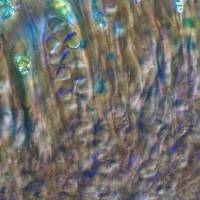
- Home
- Search
- Images
- Species Checklists
- US States: O-Z >
- US National Parks
- Central America
- South America
- US National Parks
- Southern Subpolar Region
|
Squamulea phyllidizans (Wetmore) Søchting & Bungartz
 (redirected from: Caloplaca phyllidizans Wetmore) (redirected from: Caloplaca phyllidizans Wetmore) |
|
|
Family: Teloschistaceae
[Caloplaca phyllidizans Wetmore] |
MB#836959 Basionym: Caloplaca phyllidizans Wetmore, Bryologist 106(1): 149. 2003; MB#489530. Description. Thallus distinctly subsquamulose to minutely squamulose, individual squamules ± sub-erect, giving the thallus an almost subfoliose appearance, up to 3 cm in diam. or confluent, several thalli merging, effuse, not delimited by a prothallus, hypothallus absent; surface smooth, yellowish orange, epruinose to faintly orange pruinose, with abundant, distinct, dense, marginal blastidia. Apothecia mostly sparse, sessile, up to 0.8 mm in diam., lecanorine; thalline margin slightly prominent and persistent, ~100 μm thick, regularly circular, concolorous with the thallus, epruinose, C-, K+ purple; disc flat, deep orange, darker than the margin, epruinose, C-, K+ purple; epihymenium with orange pigment granules, C+ red, K+ purple, pigmentation contiguous with the outer exciple, hymenium hyaline, not inspersed; proper exciple absent (completely reduced); thalline exciple differentiated into an inner, hyaline part, a central part with large trebouxioid photobionts, lacking crystals, and an outer, deeply brownish orange part, with abundant pigment granules, C+ red, K+ purple; subhymenium and hypothecium not differentiated, hyaline, not inspersed; asci clavate, Teloschistes-type; ascospores 8/ascus, polaribilocular, oblong to broadly ellipsoid, (8.3–)9.7–12.0(–12.8) × (3.7–)5.0–7.1(–8.2) μm, with a moderately thickened, (1.7–)2.8–4.6(–5.9) μm wide septum (n = 40). Chemistry. Thallus and apothecia P–, K+ purple, C–, KC± purplish, UV– (dull); thallus and apothecia contain a large proportion of parietin, a smaller proportion of fallacinal and very small proportions of teloschistin, parietinic acid and emodin (chemosyndrome A3 sensu Søchting 1997). Ecology and distribution. New to South America. Wetmore (2007a) previously reported the species from southwestern North America, including Mexico. In Galapagos, specimens have been found on rock or consolidated volcanic ash, rarely also on bone (carapace of a living tortoise). The species appears to be only moderately common and can typically be found in ± nitrophytic, dust-rich habitats close to the ground, in the dry, transition and humid zone. Notes. Squamulea phyllidizans is one of the few species morphologically easily distinguished from the remainder of the squamosa/subsoluta-group, characterized by distinct thallus squamules lined with abundant marginal blastidia. Only two of the three ITS sequences examined here, however, form a monophyletic group. The third sequence appears as a sister clade to species formerly referred to as ‘Huriella’, and as a sister group also of S. osseophila. Further studies are necessary to better understand the position of S. phyllidizans within the group. Squamosa phyllidizans is not only distinguished by its distinctly squamulose blastidiate thallus, but further characterized by chemosyndrome A3, whereas most specimens of the squamosa/subsoluta-group appear to be characterized by chemosyndrome A. Nash, T.H., Ryan, B.D., Gries, C., Bungartz, F., (eds.) 2007. Lichen Flora of the Greater Sonoran Desert Region. Vol 3. Life habit: lichenized Thallus: squamulose, subsquamulose, without elongated lobes; prothallus: absent surface: orange to yellowish-orange, smooth, sorediate or phyllidiate soredia: if present granular in irregular, marginal soralia cortex: cellular, 15-50 µm thick, granules absent; medulla paraplectenchymatous, without granules Apothecia: adnate, 0.3-0.8 mm in diam., lecanorine disc: orange, flat, epruinose margin: persistent, slightly raised; thalline margin present or absent, concolorous with thallus; proper margin visible, concolorous with disc parathecium: cellular (paraplectenchymatous) including exciple below hypothecium epihymenium: golden, present, K+ red, 10%N-, cN-, C- hymenium: hyaline, 60-80 µm tall paraphyses: 3-5 tip cells swollen, not branched; subhymenium hyaline asci: cylindrical, 8-spored ascospores: hyaline, 2 locules, ellipsoid, 11-14 x 5.5-7 µm, isthmus 3-4 µm, spore end wall thin Pycnidia: present, mostly immersed, ostiole orange Spot tests: apothecial margin K+ red, 10% N-, cN-; thallus K+ red, 10%N-, cN-; medulla IKI- Secondary metabolites: unidentified anthraquinones. Substrate and ecology: on non-calcareous rocks or occasionally on calcareous rocks World distribution: southwestern North America and northern Mexico Sonoran distribution: Arizona, Baja California Sur, and Sonora. Notes: Caloplaca phyllidizans has an areolate to subsquamulose thallus with some of the marginal areoles becoming elongated into short lobes. The marginal phyllidia originate as corticate outgrowths on the margins of the areoles and then often develop into soredia. The soredia sometimes are tinged bluish, similar to those of Caloplaca xanthostigmoidea This member of the C. squamosa group is distinct in its production of propagules on the areole margins. |














